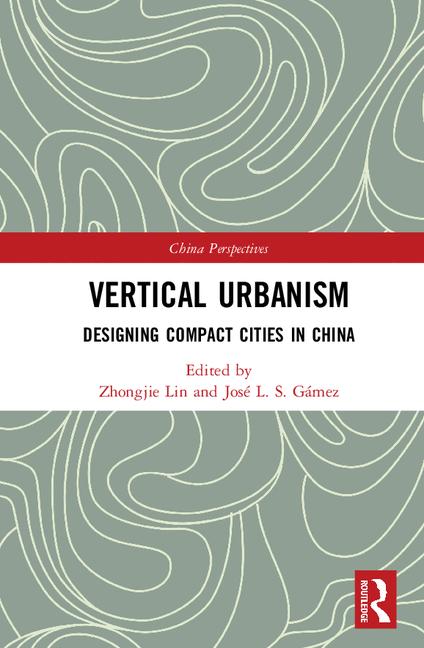
www.buildingsandcities.org/insights/reviews/vertical-urbanism-compact-cities.html
Vertical Urbanism: Designing Compact Cities in China
Edited by Zhongjie Lin and José L.S. Gámez. Routledge, 2018, ISBN: 9781138208995
 Rohinton Emmanuel (Glasgow Caledonian University)
considers this collection
of essays on the aspirations, drivers
and social needs for high-rise
developments in China in terms of creating successful urbanism focused on the
public realm.
Rohinton Emmanuel (Glasgow Caledonian University)
considers this collection
of essays on the aspirations, drivers
and social needs for high-rise
developments in China in terms of creating successful urbanism focused on the
public realm.
Vertical urbanism itself is not new. As several authors in this collection of essays themselves show (especially Stefan Al in Hong Kong and David Walters in the UK), it has been widely practiced throughout the last century and was often driven by financial motivations. What is perhaps unique is its current prominence in the sustainability/eco-city debates. If our cities become denser (and higher), what are the implications for the creation of public and open space? Can a strong case be made for vertical urbanism? The topic itself is certainly worthy of exploration.
Based on a series of US-China design pedagogy collaborations over a number of years, this book brings together teachers, students and practitioners associated with the exercise to reflect on both the particularities of the collaboration, and the wider lessons for both China and the US as well as for rapidly urbanising Asia. Organised in four parts, these essays 'frame the discourse' (Part I), explore design and transformation in China (Part II), focus on compact/eco cities (Part III) and discuss outcomes in terms of urban design proposals (Part IV). Given the diversity of authors, themes and chapters, this review considers only a few key themes from the book.
The notion of 'vertical urbanism' is developed in Part I and distinguished from mere verticality (i.e. collection of taller buildings), termed here as 'vertical cities.' The focus is on the integration of services and urban life itself in a wholistic manner and Stefan Al (Chapter 3) provides an excellent context from the point of view of Hong Kong. This and other essays in the collection make it clear that the case for vertical urbanism (and arguably its successful practice) is highly mature in Hong Kong and perhaps not so well developed in rest of China (more on this later).
Yao (Chapter 4) presents the challenges of verticality well, but this contrasts somewhat with the book's own definition of 'vertical urbanism.' Nevertheless, the point about the ageing society (a major concern not only in the West but also in Asia) and the need for a 'soft approach' (i.e. preservation of memory, public activity, accessibility, etc.) is well made. The example given here is one of the design competition entries produced by staff and students as part of this Sino-US collaboration; the fact that the 'soft approach' entry was positioned 'only the third place' in the competition is indicative of where the priorities lie (driven by developers and financiers) in the current debates surrounding verticality!
In Part II, Michael Sorkin makes an excellent case for the sort of vertical urbanism Chinese cities could aspire to ('urban villages' and danwei - a collection of work-residential units) and the issues it ought to address: Chinese cities need to address the 'limits, variety, functionality, democracy, happiness, planetary responsibility and beauty' (p. 82) that all cities will need to address sooner or later.
A cautionary tale is presented by Yi Wang (Chapter 7). In the maddeningly rapid onslaught of urbanisation, even recently developed Chinese cities are in need of regeneration (the first rapidly urbanised city - Shenzhen is also China's first to issue 'urban regeneration guidelines.') But here too, it appears old habits die hard - with conflict between local authorities' desire for 'financial balance' conflicting with community need for open space.
Perhaps the best example of vertical urbanism, as defined by the present collection comes from Zheng Tan's study of 'vertical malls.' This 'interior urbanism' (an excellent term!) is presented in fascinating details. While it attempts to recreate 'street life' inside a vertical space (so called 'privately owned public places'), it goes without saying that the air quality, air conditioning energy need and heat island consequences of such an approach are massive. The success of vertical malls as a key part of vertical urbanism so well-articulated here, begs the question whether it is feasible or even desirable elsewhere? After all, urban density in China itself is on the decline, as the book clearly shows.
Taking Shanghai as a case study, Nesbit (Chapter 9) examines the city as a 'collection of de-territorialisation and re-territorialisation processes.' It is telling that even as vertical urbanism takes hold in the largely urbanised China, building densities continue to fall (due both to urban sprawl and the demand for higher per capita living space), implying that the processes identified by Nesbit may at least partially explain the phenomenon. This raises the question as to the necessity for vertical urbanism, even in China.
A longing for 'tradition' and 'memory' is a recurring theme during the headlong dash towards globalisation and rapid urbanisation and this is well captured by Zhang and Zhou (Chapter 10) who make the case for a waterfront-friendly (hydrophilic) urbanism. The city of Suzhou, already famed for its waterfront urbanism, is shown to be in clear danger of turning its back to rivers (and in fact has already done so in areas outside its historic core).
Could vertical urbanism exist without the central role played by consumerism in the current urban boom in China? The case of Jiefangbei (and of course Hong Kong) captured by Yang (Chapter 11) is emblematic of this relationship. Based on interviews with key stakeholders, Yang shows the focus to be always on individual buildings, even when the resultant 'urban place' becomes a destination in itself. The symbiosis between developers and the state comes across strongly in this chapter, which overrides the doubts and concerns expressed by architects and urban designers. The main focus on commerce appears to exclude other aspects of urbanism (including pedestrianisation). The consequences of 'high transparent' (i.e. glass curtain wall) commercial development without regard to the public realm eventually hurts the consumerism it was intended to serve. While the challenges posed to place-making by such forms are well known internationally, the excessive focus on vertical urbanism makes the task doubly challenging in the case study city.
Part III of the book brings the focus back to the theme of 'eco city.' Yang et al (chapter 12) explore three scenarios - a typical sub-division, an 'eco-block' (exemplified by variations in building edges and building continuity within a city block) and a 'transfer of development rights' (TDR) approach where development is deferred in the urban periphery in preference to the city centre. Scenario 3 (TDR) is shown to be superior in terms of building energy use intensity (on account of the concentrated form of development), mobility and connectivity as well as outdoor thermal comfort. Lower density development (Scenario 1) had higher potential for renewable energy generation but performed poorly in other aspects. Apart from the fact that an ill-fitting thermal comfort index (predicted mean vote - PMV) is being used to evaluate outdoor comfort (Johansson et al. 2014), there are issues with the performance matrix and this is acknowledged in this chapter (for example, the weak connection between a quantitative performance-based urban modelling and the more intuitive urban design).
The case of Hong Kong in shaping and fostering vertical urbanism comes across strongly in several chapters and Hou and Song (Ch. 13) highlight the unique combination of factors that enable the flourishing of vertical urbanism - the role of governance, legal framework and a 'rational' planning process. While some of the technical requirements of the planning process in Hong Kong (such as the 'Air Ventilation Assessment' - AVA see Ng, 2009) are missing in the discussions, the focus on TDR and gross floor area (GFA) concessions are well presented. These highlight the key reason for the success of vertical urbanism in Hong Kong - a sharp focus on the public realm.
Guan (Chapter 14) shows how 'compactness' could be measured and, once the results are known, remedial action to enhance the environmental quality could be taken. It is a pity that better dialogue between this and the previous chapter is missing, which could have shown how compactness could be achieved in a sensitive manner. While this chapter advocates open space, the message from the rest of the book appears to be that it is not the quantity of open space but its quality and accessibility that is the problem.
The fact that the lessons from Hong Kong are not being learnt elsewhere in China comes across well in the next chapter (Ch 15), which quantifies the ecological transformation of Chinese cities. The typology (from 'starting up cities' to 'stable' types) recognises the role of economic development in achieving environmental sustainability but whether we have the time and space to wait for economic development to facilitate environmental conservation - especially given the wholesale urban transformation of the country - remains unanswered.
Could vertical urbanism create 'multi-functional public places in the sky'? The answer from Walters (Ch. 16) (based on the UK experience) is a definite no. While the examples peppered across the book might initially give the appearance that the experience from the East is different in this regard, a closer look suggests that the difference is not so clear cut. The fact that vertical urbanism had succeeded in Hong Kong for example, is the result of strong governance and planning practices (as highlighted by Hou and Song) - historic legacies of the UK's presence in Hong Kong. Thus, vertical urbanism could succeed, but - as highlighted by Walters - at what social cost?
The unique case of China in promoting vertical
urbanism of the 21st Century is well captured by this collection of
essays. Nevertheless, the case for vertical urbanism (even in China) is
not well made. Even if one needs
vertical urbanism, the age-old problem faced by designers of public realm
remains central to the success of any urbanism.
In the words of Jan Gehl (as quoted by Yang, p. 145): urban design must
'address life, spaces, buildings - in said order please.'
References
Johansson, E, Thorsson, S, Emmanuel, R & Krüger, E. (2014). Instruments and methods in outdoor thermal comfort studies - The need for standardization, Urban Climate, 10(2), pp. 346-366. http://dx.doi.org/10.1016/j.uclim.2013.12.002
Ng, E. (2009). Policies and technical guidelines for urban planning of high-density cities - air ventilation assessment (AVA) of Hong Kong, Building and Environment, 44(7), pp. 1478-1488. https://www.sciencedirect.com/science/article/abs/pii/S0360132308001455
Latest Peer-Reviewed Journal Content
Designing for pro-environmental behaviour change: the aspiration–reality gap
J Simpson & J Uttley
Lifetimes of demolished buildings in US and European cities
J Berglund-Brown, I Dobie, J Hewitt, C De Wolf & J Ochsendorf
Expanding the framework of urban living labs using grassroots methods
T Ahmed, I Delsante & L Migliavacca
Youth engagement in urban living labs: tools, methods and pedagogies
N Charalambous, C Panayi, C Mady, T Augustinčić & D Berc
Co-creating urban transformation: a stakeholder analysis for Germany’s heat transition
P Heger, C Bieber, M Hendawy & A Shooshtari
Placemaking living lab: creating resilient social and spatial infrastructures
M Dodd, N Madabhushi & R Lees
Church pipe organs: historical tuning records as indoor environmental evidence
B Bingley, A Knight & Y Xing
A framework for 1.5°C-aligned GHG budgets in architecture
G Betti, I Spaar, D Bachmann, A Jerosch-Herold, E Kühner, R Yang, K Avhad & S Sinning
Net zero retrofit of the building stock [editorial]
D Godoy-Shimizu & P Steadman
Co-learning in living labs: nurturing civic agency and resilience
A Belfield
The importance of multi-roles and code-switching in living labs
H Noller & A Tarik
Researchers’ shifting roles in living labs for knowledge co-production
C-C Dobre & G Faldi
Increasing civic resilience in urban living labs: city authorities’ roles
E Alatalo, M Laine & M Kyrönviita
Co-curation as civic practice in community engagement
Z Li, M Sunikka-Blank, R Purohit & F Samuel
Preserving buildings: emission reductions from circular economy strategies in Austria
N Alaux, V Kulmer, J Vogel & A Passer
Urban living labs: relationality between institutions and local circularity
P Palo, M Adelfio, J Lundin & E Brandão
Living labs: epistemic modelling, temporariness and land value
J Clossick, T Khonsari & U Steven
Co-creating interventions to prevent mosquito-borne disease transmission in hospitals
O Sloan Wood, E Lupenza, D M Agnello, J B Knudsen, M Msellem, K L Schiøler & F Saleh
Circularity at the neighbourhood scale: co-creative living lab lessons
J Honsa, A Versele, T Van de Kerckhove & C Piccardo
Positive energy districts and energy communities: how living labs create value
E Malakhatka, O Shafqat, A Sandoff & L Thuvander
Built environment governance and professionalism: the end of laissez-faire (again)
S Foxell
Co-creating justice in housing energy transitions through energy living labs
D Ricci, C Leiwakabessy, S van Wieringen, P de Koning & T Konstantinou
HVAC characterisation of existing Canadian buildings for decarbonisation retrofit identification
J Adebisi & J J McArthur
Simulation and the building performance gap [editorial]
M Donn
Developing criteria for effective building-sector commitments in nationally determined contributions
P Graham, K McFarlane & M Taheri
Join Our Community

The most important part of any journal is our people – readers, authors, reviewers, editorial board members and editors. You are cordially invited to join our community by joining our mailing list. We send out occasional emails about the journal – calls for papers, special issues, events and more.
We will not share your email with third parties. Read more



Latest Commentaries
COP30 Report
Matti Kuittinen (Aalto University) reflects on his experience of attending the 2025 UN Conference of the Parties in Belém, Brazil. The roadmaps and commitments failed to deliver the objectives of the 2025 Paris Agreement. However, 2 countries - Japan and Senegal - announced they are creating roadmaps to decarbonise their buildings. An international group of government ministers put housing on the agenda - specifying the need for reduced carbon and energy use along with affordability, quality and climate resilience.
Building-Related Research: New Context, New Challenges
Raymond J. Cole (University of British Columbia) reflects on the key challenges raised in the 34 commissioned essays for Buildings & Cities 5th anniversary. Not only are key research issues identified, but the consequences of changing contexts for conducting research and tailoring its influence on society are highlighted as key areas of action.